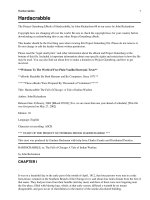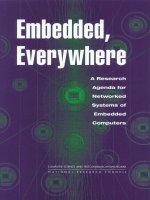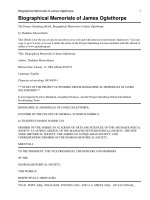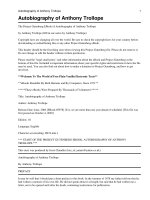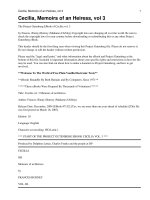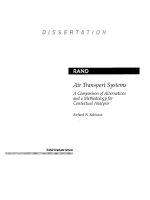Vibrations of Elastic Systems pot
Bạn đang xem bản rút gọn của tài liệu. Xem và tải ngay bản đầy đủ của tài liệu tại đây (7.72 MB, 506 trang )
Vibrations of Elastic Systems
SOLID MECHANICS AND ITS APPLICATIONS
Volume 184
Series Editor: G.M.L. GLADWELL
Department of Civil Engineering
University of Waterloo
Waterloo, Ontario, Canada N2L 3GI
Aims and Scope of the Series
The fundamental questions arising in mechanics are: Why?, How?, and How
much? The aim of this series is to provide lucid accounts written by authoritative
researchers giving vision and insight in answering these questions on the subject of
mechanics as it relates to solids.
The scope of the series covers the entire spectrum of solid mechanics. Thus
it includes the foundation of mechanics; variational formulations; computational
mechanics; statics, kinematics and dynamics of rigid and elastic bodies: vibrations
of solids and structures; dynamical systems and chaos; the theories of elasticity,
plasticity and viscoelasticity; composite materials; rods, beams, shells and mem-
branes; structural control and stability; soils, r ocks and geomechanics; fracture;
tribology; experimental mechanics; biomechanics and machine design.
The median level of presentation is the first year graduate student. Some texts are
monographs defining the current state of the field; others are accessible to final year
undergraduates; but essentially the emphasis is on readability and clarity.
For further volumes:
/>Edward B. Magrab
Vibrations of Elastic Systems
With Applications to MEMS and NEMS
123
Prof. Edward B. Magrab
Department of Mechanical Engineering
University of Maryland
College Park, MD 20742
USA
ISSN 0925-0042
ISBN 978-94-007-2671-0 e-ISBN 978-94-007-2672-7
DOI 10.1007/978-94-007-2672-7
Springer Dordrecht Heidelberg London New York
Library of Congress Control Number: 2011941768
© Springer Science+Business Media B.V. 2012
No part of this work may be reproduced, stored in a retrieval system, or transmitted in any form or by
any means, electronic, mechanical, photocopying, microfilming, recording or otherwise, without written
permission from the Publisher, with the exception of any material supplied specifically for the purpose
of being entered and executed on a computer system, for exclusive use by the purchaser of the work.
Printed on acid-free paper
Springer is part of Springer Science+Business Media (www.springer.com)
For
June Coleman Magrab
Still my muse after all these years
Preface
Vibrations occur all around us: in the human body, in mechanical systems and
sensors, in buildings and structures, and in vehicles used in the air, on the ground,
and in the water. In some cases, these vibrations are undesirable and attempts are
made to avoid them or to minimize them; in other cases, vibrations are controlled
and put to beneficial uses. Until recently, many of the application areas of vibrations
have been largely concerned with objects having one or more of its dimensions
being tens of centimeters and larger, a size that we shall denote as the macro scale.
During the last decade or so, there has been a large increase in the development
of electromechanical devices and systems at the micrometer and nanometer scale.
These developments have lead to new families of devices and sensors that require
consideration of factors that are not often important at the macro scale: viscous air
damping, squeeze film damping, viscous fluid damping, electrostatic and van der
Waals attractive forces, and the size and location of proof masses. Thus, with the
introduction of these sub millimeter systems, the range of applications and factors
has been increased resulting in a renewed interest in the field of the vibrations of
elastic systems.
The main goal of the book is to take the large body of material that has been tra-
ditionally applied to modeling and analyzing vibrating elastic systems at the macro
scale and apply it to vibrating systems at the micrometer and nanometer scale. The
models of the vibrating elastic systems that will be discussed include single and
two degree-of-freedom systems, Euler-Bernoulli and Timoshenko beams, thin rect-
angular and annular plates, and cylindrical shells. A secondary goal is to present the
material in such a manner that one is able to select the least complex model that
can be used to capture the essential features of the system being investigated. The
essential features of the system could include such effects as in-plane forces, elastic
foundations, an appropriate form of damping, in-span attachments and attachments
to the boundaries, and such complicating factors as electrostatic attraction, piezo-
electric elements, and elastic coupling to another system. To assist in the model
selection, a very large amount of numerical results has been generated so that one
is also able to determine how changes to boundary conditions, system parameters,
and complicating factors affect the system’s natural frequencies and mode shapes
and how these systems react to externally applied displacements and forces.
vii
viii Preface
The material presented is reasonably self-contained and employs only a few
solution methods to obtain the results. For continuous systems, the governing
equations and boundary conditions are derived from the determination of the con-
tributions to the total energy of the system and the application of the extended
Hamilton’s principle. Two solution methods are used to determine the natural
frequencies and mode shapes for very general boundary conditions, in-span attach-
ments, and complicating factors such as in-place forces and elastic foundations.
When possible, the Laplace transform is used to obtain the characteristic equa-
tion in terms of standard functions. For these systems, numerous special cases of
the very general solutions are obtained and tabulated. Many of these analytically
obtained results are new. For virtually all other cases, the Rayleigh-Ritz method is
used. Irrespective of the solution method, almost all solutions that are derived in
this book have been numerically evaluated by the author and presented in tables and
annotated graphs. This has resulted in a fair amount of new material.
The book is organized into seven chapters, six of which describe different vibra-
tory models for micromechanical systems and nano-scale systems and their ranges
of applicability. In Chapter 2, single and two degree-of-freedom system models
are used to obtain a basic understanding of squeeze film damping, viscous fluid
loading, electrostatic and van der Waals attractive forces, piezoelectric and electro-
magnetic energy harvesters, enhanced piezoelectric energy harvesters, and atomic
force microscopy. In Chapters 3 and 4, the Euler-Bernoulli beam is introduced. This
model is used to determine: the effects of an in-span proof mass and a proof mass
mounted at the free boundary of a cantilever beam; the applicability of elastically
coupled beams as a model for double-wall carbon nanotubes; its use as a biosensor;
the frequency characteristics of tapered beams and the response of harmonically
base-driven cantilever beams used in atomic force microscopy; the effects of elec-
trostatic fields, with and without fringe correction, on the natural frequency; the
power generated from a cantilever beam with a piezoelectric layer; and to com-
pare the amplitude frequency response of beams for various types of damping at the
macro scale and at the sub millimeter scale. Also determined in Chapter 3 is when
a single degree-of-freedom system can be used to estimate the lowest natural fre-
quency a beam with a concentrated mass and when a two degree-of-freedom system
can be used to estimate the lowest natural frequency of a beam with a concentrated
mass to which a single degree-of-freedom system is attached.
In Chapter 5, the Timoshenko theory is introduced, which gives improved
estimates for the natural frequency. One of the objectives of this chapter is to numeri-
cally show under what conditions one can use the Euler-Bernoulli beam theory and
when one should use the Timoshenko beam theory. Therefore, many of the same
systems that are examined in Chapter 3 are re-examined in this chapter and the
results from each theory are compared and regions of applicability are determined.
The transverse and extensional vibrations of thin rectangular and annular cir-
cular plates are presented in Chapter 6. The results of extensional vibrations of
circular plates have applicability to MEMS resonators for RF devices. In the last
chapter, Chapter 7, the Donnell and Flügge shell theories are introduced and used to
Preface ix
obtain approximate natural frequencies and mode shapes of single-wall and double-
wall carbon nanotubes. The results from these shell theories are compared to those
predicted by the Euler-Bernoulli and Timoshenko beam theories.
I would like to thank my colleagues Dr. Balakumar Balachandran for his encour-
agement to undertake this project and his continued support to its completion and
Dr. Amr Baz for his assistance with some of the material on beam energy harvesters.
I would also like to acknowledge the students in my 2011 spring semester graduate
class where much of this material was “field-tested.” Their comments and feedback
led to several improvements.
College Park, Maryland Edward B. Magrab
Contents
1 Introduction 1
1.1 A Brief Historical Perspective . 1
1.2 Importance of Vibrations 1
1.3 AnalysisofVibratingSystems 2
1.4 About the Book 3
Reference 6
2 Spring-Mass Systems 7
2.1 Introduction . 7
2.2 SomePreliminaries 7
2.2.1 A Brief Review of Single Degree-of-Freedom Systems . . 7
2.2.2 General Solution: Harmonically Varying Forcing . 10
2.2.3 Power Dissipated by a Viscous Damper . . 13
2.2.4 StructuralDamping 15
2.3 Squeeze Film Air Damping . . . 16
2.3.1 Introduction . . 16
2.3.2 Rectangular Plates 17
2.3.3 CircularPlates 20
2.3.4 Base Excitation with Squeeze Film Damping . . . 21
2.3.5 Time-VaryingForceExcitationoftheMass 24
2.4 Viscous Fluid Damping 26
2.4.1 Introduction . . 26
2.4.2 Single Degree-of-Freedom System in a Viscous Fluid . . . 28
2.5 ElectrostaticandvanderWaalsAttraction 30
2.5.1 Introduction . . 30
2.5.2 Single Degree-of-Freedom System with
ElectrostaticAttraction 31
2.5.3 van der Waals Attraction and Atomic Force Microscopy . . 38
2.6 EnergyHarvesters 41
2.6.1 Introduction . . 41
2.6.2 Piezoelectric Generator . 42
2.6.3 Maximum Average Power of a Piezoelectric Generator . . 48
2.6.4 Permanent Magnet Generator . . . 53
xi
xii Contents
2.6.5 Maximum Average Power of a Permanent
Magnetic Generator . . . 55
2.7 Two Degree-of-Freedom Systems 56
2.7.1 Introduction . . 56
2.7.2 Harmonic Excitation: Natural Frequencies
and Frequency-Response Functions 59
2.7.3 Enhanced Energy Harvester 65
2.7.4 MEMS Filters . 71
2.7.5 Time-Domain Response . 73
2.7.6 Design of an Atomic Force Microscope Motion
Scanner 73
Appendix 2.1 Forces on a Submerged Vibrating Cylinder 75
References 80
3 Thin Beams: Part I 83
3.1 Introduction . 83
3.2 Derivation of Governing Equation and Boundary Conditions . . . 84
3.2.1 ContributionstotheTotalEnergy 84
3.2.2 GoverningEquation 95
3.2.3 Boundary Conditions . . 96
3.2.4 Non Dimensional Form of the Governing Equation
and Boundary Conditions 101
3.3 Natural Frequencies and Mode Shapes of Beams
with Constant Cross Section and with Attachments 103
3.3.1 Introduction . . 103
3.3.2 Solution for Very General Boundary Conditions . . 103
3.3.3 General Solution in the Absence of an Axial Force
and an Elastic Foundation 109
3.3.4 NumericalResults 121
3.3.5 Cantilever Beam as a Biosensor . . 133
3.4 Single Degree-of-Freedom Approximation of Beams
with a Concentrated Mass 134
3.5 Beams with In-Span Spring-Mass Systems 137
3.5.1 Single Degree-of-Freedom System 137
3.5.2 Two Degree-of-Freedom System with Translation
andRotation 144
3.6 Effects of an Axial Force and an Elastic Foundation
on the Natural Frequency 149
3.7 Beams with a Rigid Extended Mass . . . 150
3.7.1 Introduction . . 150
3.7.2 Cantilever Beam with a Rigid Extended Mass . . . 150
3.7.3 Beam with an In-Span Rigid Extended Mass 154
3.8 BeamswithVariableCrossSection 164
3.8.1 Introduction . . 164
3.8.2 Continuously Changing Cross Section . . . 165
Contents xiii
3.8.3 Linear Taper . . 168
3.8.4 Exponential Taper 173
3.8.5 Approximate Solutions to Tapered Beams:
Rayleigh-RitzMethod 175
3.8.6 Triangular Taper: Application to Atomic Force
Microscopy 182
3.8.7 Constant Cross Section with a Step Change
in Properties . . 183
3.8.8 Stepped Beam with an In-Span Rigid Support . . . 193
3.9 Elastically Connected Beams . . 197
3.9.1 Introduction . . 197
3.9.2 Beams Connected by a Continuous Elastic Spring . 199
3.9.3 Beams with Concentrated Masses Connected by an
ElasticSpring 201
3.10ForcedExcitation 203
3.10.1 Boundary Conditions and the Generation of
Orthogonal Functions . . 203
3.10.2 General Solution 205
3.10.3 Impulse Response 208
3.10.4 Time-Dependent Boundary Excitation . . . 210
3.10.5 Forced Harmonic Oscillations . . 216
3.10.6 Harmonic Boundary Excitation . . 217
References 218
4 Thin Beams: Part II 221
4.1 Introduction . 221
4.2 Damping 221
4.2.1 Generation of Governing Equation 221
4.2.2 General Solution 227
4.2.3 Illustration of the Effects of Various Types of
Damping: Cantilever Beam 231
4.3 In-PlaneForcesandElectrostaticAttraction 239
4.3.1 Introduction . . 239
4.3.2 Beam Subjected to a Constant Axial Force . 240
4.3.3 Beam Subject to In-Plane Forces
andElectrostaticAttraction 243
4.4 Piezoelectric Energy Harvesters 252
4.4.1 Governing Equations and Boundary Conditions . . 252
4.4.2 Power from the Harmonic Oscillations of a
Base-Excited Cantilever Beam . . 260
Appendix 4.1 Hydrodynamic Correction Function 268
References 270
5 Timoshenko Beams 273
5.1 Introduction . 273
5.2 Derivation of the Governing Equations and Boundary
Conditions 273
xiv Contents
5.2.1 Introduction . . 273
5.2.2 ContributionstotheTotalEnergy 275
5.2.3 GoverningEquations 280
5.2.4 Boundary Conditions . . 281
5.2.5 Non Dimensional Form of the Governing
Equations and Boundary Conditions 284
5.2.6 Reduction of the Timoshenko Equations to That
ofEuler-Bernoulli 286
5.3 Natural Frequencies and Mode Shapes of Beams
with Constant Cross Section, Elastic Foundation,
Axial Force, and In-span Attachments . . 287
5.3.1 Introduction . . 287
5.3.2 Solution for Very General Boundary Conditions . . 289
5.3.3 Special Cases . 295
5.3.4 NumericalResults 300
5.4 Natural Frequencies of Beams with Variable Cross Section 310
5.4.1 Beams with a Continuous Taper: Rayleigh-Ritz Method . . 310
5.4.2 Constant Cross Section with a Step Change
in Properties . . 314
5.4.3 NumericalResults 322
5.5 Beams Connected by a Continuous Elastic Spring . 325
5.6 ForcedExcitation 328
5.6.1 Boundary Conditions and the Generation of
Orthogonal Functions . . 328
5.6.2 General Solution 329
5.6.3 Impulse Response 333
Appendix 5.1 Definitions of the Solution Functions f
l
and g
l
andTheirDerivatives 335
Appendix 5.2 Definitions of Solution Functions f
li
and g
li
andTheirDerivatives 337
References 338
6ThinPlates 341
6.1 Introduction . 341
6.2 Derivation of Governing Equation and Boundary
Conditions: Rectangular Plates . 342
6.2.1 Introduction . . 342
6.2.2 ContributionstotheTotalEnergy 344
6.2.3 GoverningEquations 348
6.2.4 Boundary Conditions . . 349
6.2.5 Non Dimensional Form of the Governing Equation
and Boundary Conditions 352
6.3 Governing Equations and Boundary Conditions: Circular Plates . . 354
6.4 Natural Frequencies and Mode Shapes of Circular Plates
for Very General Boundary Conditions . . 356
Contents xv
6.4.1 Introduction . . 356
6.4.2 Natural Frequencies and Mode Shapes of Annular
andSolidCircularPlates 359
6.4.3 NumericalResults 363
6.5 Natural Frequencies and Mode Shapes of Rectangular
and Square Plates: Rayleigh-Ritz Method 370
6.5.1 Introduction . . 370
6.5.2 Natural Frequencies and Mode Shapes of
Rectangular and Square Plates . . 371
6.5.3 NumericalResults 374
6.5.4 ComparisonwithThinBeams 379
6.6 ForcedExcitationofCircularPlates 382
6.6.1 General Solution to the Forced Excitation of
CircularPlates 382
6.6.2 Impulse Response of a Solid Circular Plate . 387
6.7 Circular Plate with Concentrated Mass Revisited . 389
6.8 Extensional Vibrations of Plates 390
6.8.1 Introduction . . 390
6.8.2 ContributionstotheTotalEnergy 391
6.8.3 Governing Equations and Boundary Conditions . . 392
6.8.4 Natural Frequencies and Mode Shapes of a Circular Plate . 395
6.8.5 NumericalResults 397
Appendix 6.1 Elements of Matrices in Eq. (6.100) 399
References 399
7 Cylindrical Shells and Carbon Nanotube Approximations 401
7.1 Introduction . 401
7.2 Derivation of Governing Equations and Boundary
Conditions: Flügge’s Theory . . 402
7.2.1 Introduction . . 402
7.2.2 ContributionstotheTotalEnergy 407
7.2.3 GoverningEquations 410
7.2.4 Boundary Conditions . . 411
7.2.5 Boundary Conditions and the Generation of
Orthogonal Functions . . 414
7.3 Derivation of Governing Equations and Boundary
Conditions: Donnell’s Theory . . 415
7.3.1 Introduction . . 415
7.3.2 ContributiontotheTotalEnergy 417
7.3.3 GoverningEquations 418
7.3.4 Boundary Conditions . . 419
7.4 Natural Frequencies of Clamped and Cantilever Shells:
Single-Wall Carbon Nanotube Approximations . . 420
7.4.1 Rayleigh-RitzSolution 420
7.4.2 NumericalResults 424
xvi Contents
7.5 Natural Frequencies of Hinged Shells: Double-Wall
Carbon Nanotube Approximation 432
References 436
Appendix A
Strain Energy in Linear Elastic Bodies 439
Reference 441
Appendix B
Variational Calculus: Generation of Governing Equations,
Boundary Conditions, and Orthogonal Functions 443
B.1 Variational Calculus . . 443
B.1.1 System with One Dependent Variable . . . 443
B.1.2 A Special Case for Systems with One Dependent
Variable 452
B.1.3 Systems with N Dependent Variables 455
B.1.4 A Special Case for Systems with N Dependent
Variables 461
B.2 Orthogonal Functions . 463
B.2.1 Systems with One Dependent Variable . . . 463
B.2.2 Systems with N Dependent Variables 468
B.3 Application of Results to Specific Elastic Systems . 473
Reference 476
Appendix C
Laplace Transforms and the Solutions to Ordinary
Differential Equations 477
C.1 Definition of the Laplace Transform . . . 477
C.2 Solution to a Second-Order Equation . . . 478
C.3 SolutiontoaFourth-OrderEquation 479
C.4 TableofLaplaceTransformPairs 483
Reference 484
Index 485
Chapter 1
Introduction
1.1 A Brief Historical Perspective
It is likely that the early interest in vibrations was due to the development of musi-
cal instruments such as whistles and drums. In was in modern times, starting around
1583, when Galilei Galileo made his observations about the period of a pendu-
lum, that the subject of vibrations attracted scientific scrutiny. In the 1600’s, strings
were analyzed by Marin Mersenne and John Wallis; in the 1700’s, beams were ana-
lyzed by Leonhard Euler and Daniel Bernoulli and plates were analyzed by Sophie
Germain; in the 1800’s, plates were analyzed by Gustav Kirchhoff and Simeon
Poisson, and shells by D. Codazzi and A. E. H. Love. A complete historical devel-
opment of the subject can be found in (Love, 1927). Lord Rayleigh’s book Theory of
Sound, which was first published in 1877, is one of the early comprehensive publi-
cations on the subject of vibrations. Since the publication of his book, there has been
considerable growth in the diversity of devices and systems that are designed with
vibrations in mind: mechanical, electromechanical, biomechanical and biomedical,
ships and submarines, and civil structures. Along with this explosion of interest in
quantifying the vibrations of systems, came great advances in the computational and
analytical tools available to analyze them.
1.2 Importance of Vibrations
Vibrations occur all around us. In the human body, where there are low-frequency
oscillations of the lungs and the heart and high-frequency oscillations of the larynx
as one speaks. In man-made systems, where any unbalance in machines with rotat-
ing parts such as fans, washing machines, centrifugal pumps, rotary presses, and
turbines, can cause vibrations. In buildings and structures, where passing vehicular,
air, and rail traffic or natural phenomena such as earthquakes and wind can cause
oscillations.
In some cases, oscillations are undesirable. In structural systems, the fluctuating
stresses due to vibrations can result in fatigue failure. When performing precision
measurements such as with an electron microscope externally caused oscillations
1
E.B. Magrab, Vibrations of Elastic Systems, Solid Mechanics and Its Applications 184,
DOI 10.1007/978-94-007-2672-7_1,
C
Springer Science+Business Media B.V. 2012
2 1 Introduction
must be substantially minimized. In air, roadway, and railway vehicles, oscillatory
input to the passenger compartments must be reduced. In machinery, vibrations
can cause excessive wear or cause situations that make a device difficult to con-
trol. Vibrating systems can also produce unwanted audible acoustic energy that is
annoying or harmful.
On the other hand, vibrations also have many beneficial uses in such widely
diverse applications as vibratory parts feeders, paint mixers, transducers and sen-
sors, ultrasonic devices used in medicine and dentistry, sirens and alarms for
warnings, determining fundamental properties of materials, and stimulating bone
growth.
During the last decade or so, there has been a increase in the development of
electromechanical devices and systems at the micrometer and nanometer scale.
The introduction of these artifacts at this sub millimeter scale has created renewed
interest in the vibrations of elastic systems. These developments have lead to new
families of devices and sensors such as vibrating cantilever beam mass sensors,
piezoelectric beam energy harvesters, carbon nanotube oscillators, and vibrating
cantilever beam sensors for atomic force microscopes. Along with these devices
come additional effects that are important at this scale such as viscous air damping,
squeeze film damping, electrostatic attraction, and the size and location of a proof
mass. Thus, the range of applications that the vibration of elastic systems has to
consider has been increased.
1.3 Analysis of Vibrating Systems
The analyses of systems subject to vibrations or designed to vibrate have many
aspects. Typically, a system is designed to meet a set of vibration performance cri-
teria such as to oscillate at a specific frequency, avoid a system resonance, operate
at or below specific amplitude levels, have its response controlled, and be isolated
from its surroundings. These criteria may involve the entire system or only specific
portions of it. To determine if the performance criteria have been met, experiments
are performed to determine the characteristics of the input to the system, the output
from the system, and the system itself. Some of the characteristics of interest could
be whether the input is harmonic, periodic, transient, or random and its respec-
tive frequency content and magnitude. Some of the characteristics of the output of
the system could be the magnitude and frequency content of the force, velocity,
displacement, acceleration, or stress at one or more locations. Some of the charac-
teristics of the system itself could be its natural frequencies and mode shapes and
its response to a specific input quantity.
To design a system to meet its performance criteria, it is often necessary to
model the system and then to analyze it in the context of these criteria. The type
of model one uses may be a function of its size: the sub micrometer scale, microm-
eter scale, millimeter scale, or the centimeter scale and greater, which we denote as
the macro scale. The model will also be a function of its shape, the way in which i t is
1.4 About the Book 3
expected to oscillate, the way it is supported, and how it is constrained. If shape can
be ignored, then the system can be modeled as a spring-mass system. If geometry
is important, then one must choose an appropriate representation such as a beam,
plate, or shell and decide if the geometry can be treated as a constant geometry or if
it must be treated as a s ystem with variable geometry. The system’s environment, in
conjunction with its size, will determine which type of damping is important and if
it must be taken into account. The model may also have to include the effects of any
attachments to its interior and to its boundaries and may have to account for exter-
nally applied constraints and forces such as an elastic foundation, in-plane forces,
and coupling to other elastic systems. Thus, there are many decisions that must be
made with regard to what should be included in the model so that it adequately
represents the actual system.
1.4 About the Book
The main goal of the book is to take the large body of material that has been tradi-
tionally applied to modeling and analyzing vibrating elastic systems at the macro
scale and apply it to vibrating s ystems at the micrometer and nanometer scale.
The models of the vibrating elastic systems that will be discussed include single
and two degree-of-freedom spring-mass systems, Euler-Bernoulli and Timoshenko
beams, thin rectangular and annular plates, and cylindrical shells. A second goal is
to present the material in such a manner that one is able to select the least complex
model that can be used to capture the essential features of the system being inves-
tigated. The essential features of the system could include such effects as in-plane
forces, elastic foundations, an appropriate form of damping, in-span attachments
and attachments to t he boundaries, and such complicating factors as electrostatic
attraction, piezoelectric elements, and elastic coupling to another system. To assist
in the model selection, a very large amount of numerical results has been gener-
ated so that one is able compare the various models to determine how changes to
boundary conditions, system parameters, and complicating factors affect the natural
frequencies and mode shapes and the response to externally applied displacements
and forces.
In order to be able to cover the wide range of models and complicating factors
in sufficient detail, an efficient means of presenting the material is required. The
approach employed here has been to obtain an expression for the total energy of
each model and then to use the extended Hamilton’s principle to derive the govern-
ing equations and boundary conditions. The expression for the total energy of the
system includes the effects of any complicating factors. In addition to providing an
efficient and consistent way in which to obtain the governing equations and bound-
ary conditions, the expression for the total energy of the system can be used directly
as the starting point for the Rayleigh-Ritz method. Another advantage of the energy
approach is that the results given here can be extended to systems that include other
effects by modifying the expression for the total energy. The expressions used to
4 1 Introduction
Table 1.1 The elastic systems considered in this book. Typical MEMS and NEMS applications of these systems are described in Table 1.2
System Additional factors Cross section
Boundary
attachments
In-Span
attachments
Spring-Mass Single degree-of-freedom Damping: structural, viscous,
squeeze film, viscous fluid
Electrostatic force
van der Waals force
Magnetic force
Piezoelectric element
–––
Two degree-of-freedom Piezoelectric element – – –
Beams Euler-Bernoulli theory Damping: structural, viscous,
squeeze film, viscous fluid,
viscous air
Axial force
Elastic foundation
Electrostatic force
Elastic coupling to another
beam
Layered beams
Constant
Continuously variable
Constant with abrupt
change in
properties
Translation spring
Torsion spring
Concentrated mass
Extended mass
Translation spring
Concentrated mass
Single degree-of-freedom
system
Finite-length rigid mass
Timoshenko theory Axial force
Elastic foundation
Elastic coupling to another
beam
Constant
Continuously variable
Constant with abrupt
change in
properties
Translation spring
Torsion spring
Concentrated mass
Translation spring
Torsion spring
Concentrated mass
Single degree-of-freedom
system
Thin Plates Rectangular – Constant – Concentrated mass
Circular In-plane force
Elastic foundation
Extensional oscillations
Constant Translation spring
Torsion spring
Concentrated mass
Concentrated mass
Thin Cylindrical
Shells
Donnell’s theory
Flügge’s theory
Elastic coupling to another
shell
Constant – –
1.4 About the Book 5
arrive at the governing equations and boundary conditions will be the same. A list
of the elastic systems and their additional factors that are considered in this book
to model microelectromechanical and nano electromechanical systems are given in
Table 1.1 and the corresponding specific applications associated with these elastic
systems are given in Table 1.2.
To make the application of the energy approach more efficient, an appendix,
Appendix B, is provided with a general derivation of the extended Hamilton’s prin-
ciple for systems with one or more dependent variables and it is shown there the
conditions required in order for one to be able to generate orthogonal functions.
Since a primary solution method employed in this book is the separable of variables,
the generation and use of orthogonal functions is very important. Consequently, the
use of energy approach, the application of the extended Hamilton’s principle, and
the results of Appendix B provide the basis for a consistent approach to deriving the
governing equations and boundary conditions and the basis for two very powerful
solution techniques: the generation of orthogonal functions and the separation of
variables and the Rayleigh-Ritz method. It will be seen that a major advantage of
the use of the extended Hamilton’s principle is that the boundary conditions are a
natural consequence of the method. This will prove to be very important when the
Timoshenko beam theory, thin plate theory, and thin cylindrical shell theories are
considered. In these cases, obtaining the boundary conditions can be quite involved
if the force balance and moment balance methods are used.
To determine the effects that various parameters and complicating factors have
on a system, the following procedure is employed. For each elastic system, a solu-
tion for a very general set of boundary conditions and complicating factors as is
practical is obtained. Once the general solution has been obtained, many of its spe-
cial cases are examined in a direct and straightforward manner. This approach, while
Table 1.2 Typical MEMS and NEMS application areas of the elastic systems described in
Table 1.1
System Typical MEMS and NEMS Applications
Spring-Mass Single degree-of-freedom Piezoelectric and magnetic energy harvesters
Atomic force microscopy
Two degree-of-freedom Enhanced piezoelectric energy harvester
Filters
Atomic force microscopy
Beams Euler-Bernoulli theory Biosensors
Effects of proof mass
Piezoelectric energy harvester
Atomic force microscopy
Electrostatic devices
Timoshenko theory Single- and double-wall carbon nanotubes
Thin Plates Rectangular –
Circular RF devices
Thin Cylindrical
Shells
Donnell’s theory
Flügge’s theory
Single- and double-wall carbon nanotubes
6 1 Introduction
introducing a little more algebraic complexity at the outset, is a very efficient way
of obtaining a solution to a class of systems and greatly reduces the need to re-solve
and/or re-derive the equations each time another combination of factors is exam-
ined. In most cases, many of the systems’ special cases are listed in tables. As a
consequence, in several cases, new analytical results have been obtained.
In order to be able to use the least complex model to represent a system, each
subsequent system is compared to a simpler model. For example, the conditions
under which a beam with a concentrated mass can be modeled as a single degree-
of-freedom system are determined. Other examples are the determination of the
conditions when a beam can be used to model a narrow thin plate and when the
Euler-Bernoulli beam theory can be used instead of the Timoshenko beam theory.
An underlying aspect that allows one to present the large amount of material
given in this book is the availability of the modern computer environments such as
MATLAB
R
and Mathematica
R
. These programs permit one to devote less space
to presenting special numerical solution techniques and more space to the devel-
opment of the governing equations and boundary conditions, obtaining the general
solutions, and presenting and discussing the numerical results. Consequently, vir-
tually all solutions that are derived in this book have been numerically evaluated.
This has produced a substantial amount of annotated graphical and tabular results
that illustrate the influence that the various system parameters have on their respec-
tive responses. Many of these numerical results are new. In addition, the numerical
results are presented in terms of non dimensional quantities making them applicable
to a wide range of systems.
Reference
Love AEH (1927) A treatise of the mathematical theory of elasticity, 4th edn. Dover, New York,
NY, pp 1–31
Chapter 2
Spring-Mass Systems
The single degree-of-freedom system subject to mass and base excitation is used
to model an elastic system to determine the frequency-domain effects of squeeze
film air damping and viscous fluid damping. This model is also used to deter-
mine the important response characteristics of electrostatic attraction and van der
Waals forces, the maximum average power from piezoelectric and electromagnetic
coupling, and to illustrate the fundamental working principle of an atomic force
microscope. The two degree-of-freedom system is introduced to examine micro-
electromechanical filters, atomic force microscope specimen control devices, and as
a means to increase the input to piezoelectric energy harvesters. An appendix gives
the details of the derivation of a hydrodynamic function that expresses the effects of
a viscous fluid on a vibrating cylinder.
2.1 Introduction
In determining the response of structural systems in the subsequent chapters, it will
be seen that the different models frequently reduce to that of a set of single degree of
freedom systems. Thus, a basic understanding of the response of single degree-of-
freedom systems in general and its response when the system is subjected to various
complicating factors such as squeeze film damping, viscous fluid loading, electro-
static attraction, and piezoelectric and electromagnetic coupling is required. In this
chapter, we shall analyze such systems in the absence of the structural aspects; in
the subsequent chapters, the structure will be taken into account.
2.2 Some Preliminaries
2.2.1 A Brief Review of Single Degree-of-Freedom Systems
A single degree-of-freedom system is shown in Fig. 2.1. The static displacement of
the mass is δ
st
. The mass undergoes a displacement x (t) and the rigid container a
7
E.B. Magrab, Vibrations of Elastic Systems, Solid Mechanics and Its Applications 184,
DOI 10.1007/978-94-007-2672-7_2,
C
Springer Science+Business Media B.V. 2012
8 2 Spring-Mass Systems
(b)(a)
y
mg
m
f
o
+ f (t)
f
o
+ f (t)
x
δ
st
ck
m
F
s
F
d
mg
Fig. 2.1 (a) Vertical vibrations of a spring-mass-damper system (b) Free-body diagram
known displacement y (t). Both of these displacements are with respect to an inertial
frame. The relationship between these two displacements is
z
(
t
)
= x
(
t
)
− y
(
t
)
. (2.1)
The mass is subjected to an externally applied constant force f
o
, a time-varying
force f (t), and a reaction force F
r
(
z, ˙z, ¨z
)
. This reaction force has been introduced
so that forces that are produced by such phenomena as squeeze film damping, elec-
trostatic attraction, and viscous fluids can be straightforwardly incorporated. When
the rigid container is stationary, y (t) = 0 and z (t) = x(t).
Referring to Fig. 2.1b, a summation of forces on the mass m in the vertical
direction gives
m
d
2
x
dt
2
+ F
s
+ F
d
+ F
r
(
z, ˙z, ¨z
)
= mg +f
o
+ f (t) (2.2)
where the over dot indicates the derivative with respect to the time t and g =
9.81 m/s
2
is the acceleration of gravity. The constant force f
o
can be caused, for
example, by an electrostatic attraction (see Section 2.5.2), by a pressure difference
between the top and bottom surfaces of the mass, and by a magnetic force if the
mass were composed of a magnetic material.
When the spring is linear, F
s
= k
(
z + δ
st
)
, where k is the spring constant (N/m).
The spring constant k is sometimes referred to as the derivative of the spring force
since dF
s
/dz = k. When the damper is a linear viscous damper, F
d
= c˙z, where c is
the damper constant (Ns/m). For this case, Eq. (2.2) becomes
m
d
2
x
dt
2
+ c
dz
dt
+ k
(
z + δ
st
)
+ F
r
(
z, ˙z, ¨z
)
= mg +f
o
+ f (t). (2.3)

